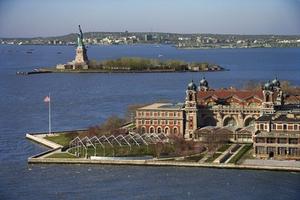Infrastructure protectionExtreme weather events threaten U.S. national landmarks
Rising seas, floods, and wildfires are threatening the U.S. most cherished historic sites — from Ellis Island to the Everglades, Cape Canaveral to California’s César Chávez National Monument. Scientists say that today these sites face an uncertain future in a world of rising sea levels, more frequent wildfires, increased flooding, and other damaging effects of climate change. At some sites — such as Liberty and Ellis Islands and Cape Hatteras — steps have already been taken to prepare for these growing climate risks. At many other sites, such efforts have not yet begun.

Ellis Island, Liberty Island in background // Source: nps.gov
The growing consequences of climate change are putting many of the country’s most iconic and historic sites at risk.
From Ellis Island to the Everglades, Cape Canaveral to California’s César Chávez National Monument, these sites symbolize values that unite all Americans — patriotism, freedom, democracy, and more. The Union of Concerned Scientists (UCS) says that today these sites face an uncertain future in a world of rising sea levels, more frequent wildfires, increased flooding, and other damaging effects of climate change.
The organization calls for better preparation of these cherished landmarks for the worsening climate impacts, and for taking steps to make climate resilience a national priority. UCS says that at the same time, the United States must work to minimize these risks in the future by reducing the carbon emissions that are causing climate change and its accompanying impacts.
A new UCS report highlights thirty at-risk locations chosen because the science behind the risks they face is robust, and because together they shine a spotlight on the different kinds of climate impacts already affecting the U.S. cultural heritage.
At some sites — such as Liberty and Ellis Islands and Cape Hatteras — steps have already been taken to prepare for these growing climate risks. At many other sites, such efforts have not yet begun.
UCS notes that these case studies illustrate that climate change is no longer a distant threat for others to worry about. The consequences are already underway, with serious and growing risks to the places and communities we care about.
“If future generations of Americans are to experience the joy and wonder that these extraordinary places engender, we must act now to protect them from the impacts of climate change today and prepare them for expected additional changes tomorrow,” a blog entry on the UCS Web site says. “The historic legacy of the United States is at stake.”
National landmarks at risk: Case study sites
- Alaska: Cape Krusenstern National Monument and Kivalina— Bering Land Bridge National Monument and Shishmaref
- California: Groveland— César E. Chávez National Monument— NASA Ames Research Center
- Colorado: Mesa Verde National Park
- Florida: Castillo de San Marcos, Fort Mose, St. Augustine’s historic downtown, and the Lincolnville Historic District in St. Augustine— Prehistoric shell structures at Ten Thousand Islands and Canaveral National Seashore— NASA Kennedy Space Center in Cape Canaveral
- Hawaii: Kaloko-Honokōhau and Pu’uhonua o Hōnaunau National Historic Parks
- Louisiana: NASA Michoud Assembly Facility
- Maryland: Harriet Tubman Underground Railroad National Monument— Historic Annapolis and U.S. Naval Academy
- Massachusetts: Boston’s Faneuil Hall and the Blackstone Block Historic District
- Mississippi: NASA Stennis Space Center
- New Mexico: Bandelier National Monument and Santa Clara Pueblo
- New York: Statue of Liberty and Ellis Island
- North Carolina: Cape Hatteras Lighthouse
- South Carolina: Charleston’s Historic District
- Texas: Johnson Space Center
- Virginia: Historic Jamestown— Fort Monroe National Monument— NASA Wallops Flight Facility and Langley Research Center
— Read more in Debra Holtz et al., National Landmarks at Risk How Rising Seas, Floods, and Wildfires Are Threatening the United States’ Most Cherished Historic Sites (Union of Concerned Scientists, May 2014)
